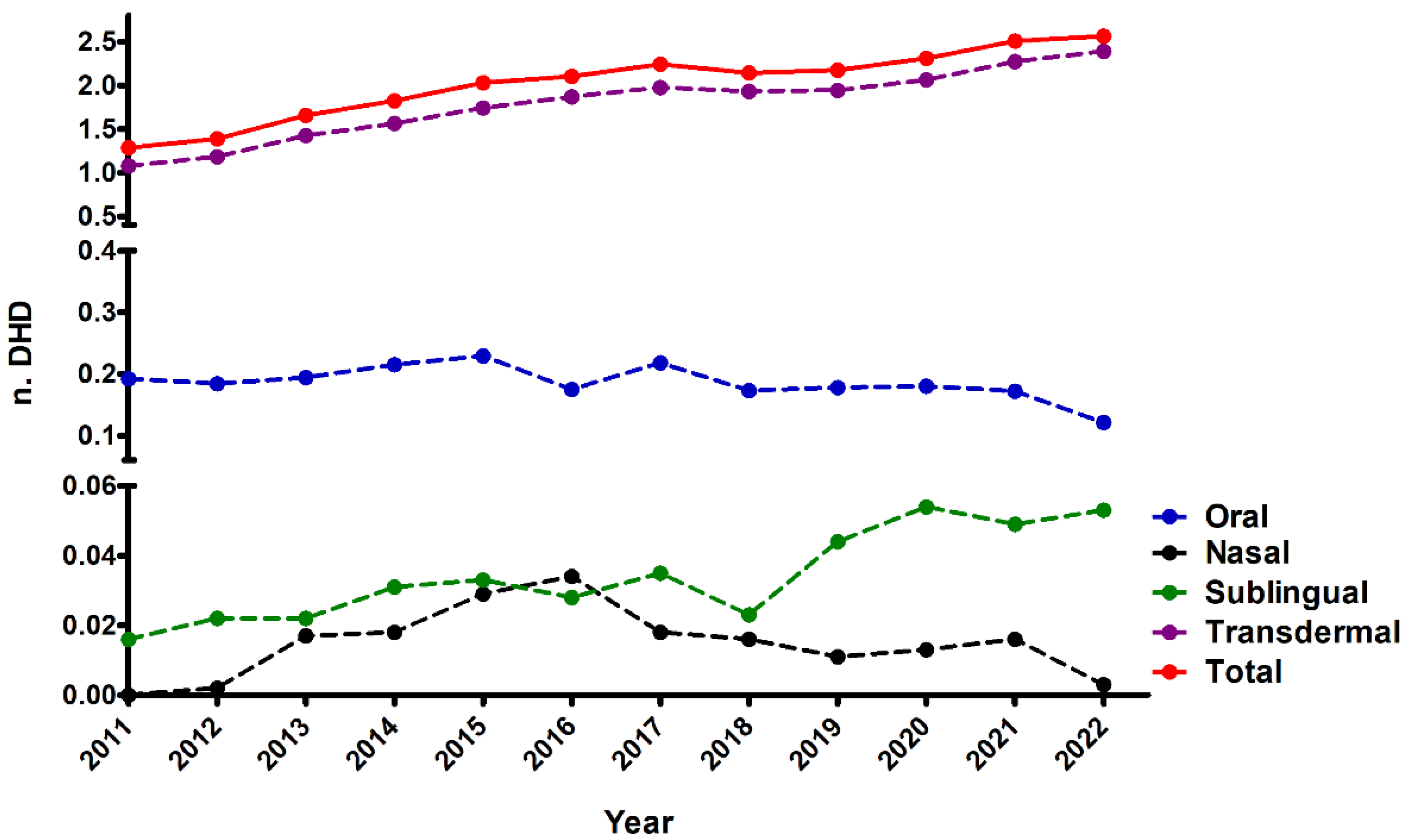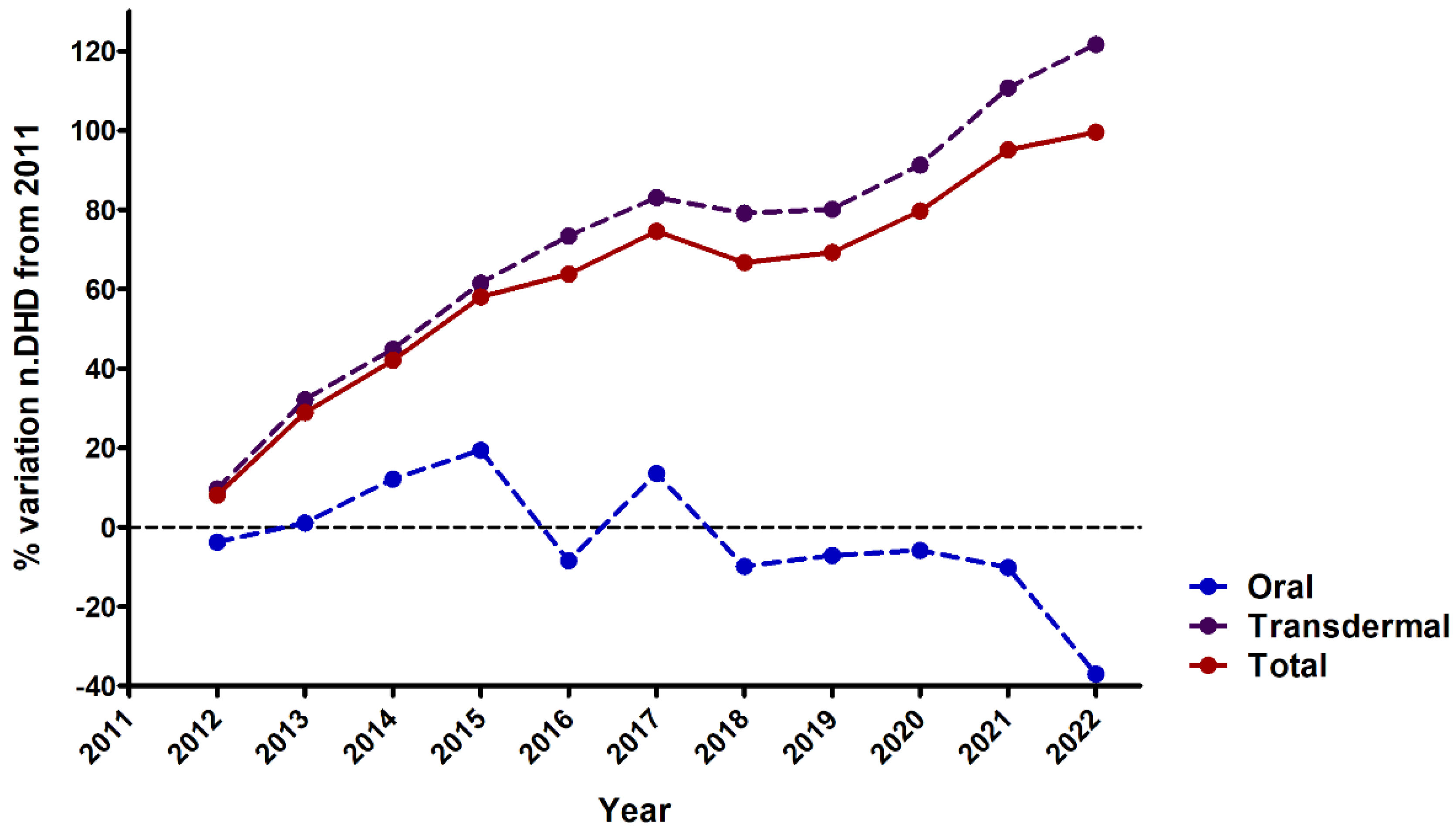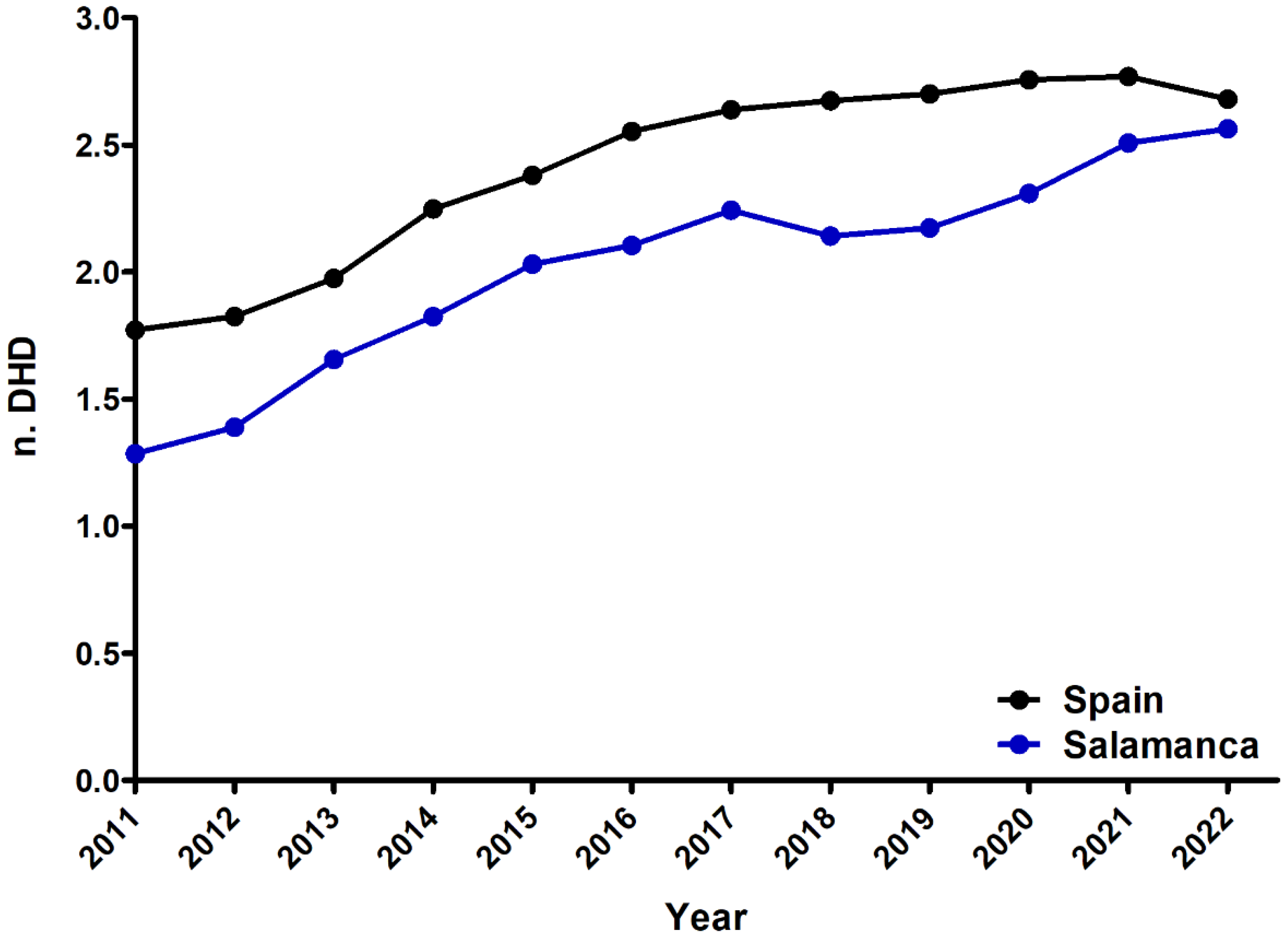Evolution of Fentanyl Prescription Patterns and Administration Routes in Primary Care in Salamanca, Spain: A Comprehensive Analysis from 2011 to 2022
Abstract
1. Introduction
2. Materials and Methods
2.1. Data Search Using Official Websites
- -
- Data on the use of immediate-release fentanyl in Castilla y León were searched for in the Portal del medicamento del Sacyl (Drug Information Centre in Castilla y León) https://www.saludcastillayleon.es/portalmedicamento/es/ (accessed on 8 May 2024) [24].
- -
- Data on fentanyl misuse in Spain were obtained from the Spanish Observatory on Drugs and Addictions (OEDA): https://pnsd.sanidad.gob.es/profesionales/sistemasInformacion/home.htm (accessed on 8 May 2024) [20].
- -
- In terms of the use of opioid medicines in Spain, data on the consumption rates of fentanyl, expressed in DHD, and reports on the prescription of immediate-use fentanyl were searched for in the Observatory on the Use of Medicines, Spanish Agency for Medicines and Health Products (AEMPS) https://www.aemps.gob.es/medicamentos-de-uso-humano/observatorio-de-uso-de-medicamentos/utilizacion-de-medicamentos-opioides-en-espana/ (accessed on 8 May 2024) [25].
- -
- Data on the prevalence of the consumption of fentanyl in the US were found at the National Survey on Drug Use and Health (NSDUH), Substance Abuse and Mental Health Services Administration (SAMHSA) https://www.samhsa.gov/data/data-we-collect/nsduh-national-survey-drug-use-and-health (accessed on 8 May 2024) [26].
2.2. Access to Open Public Data
2.3. Data Analysis
3. Results
3.1. Prevalence of Fentanyl Use in the Province of Salamanca
3.2. Comparison of the Prevalence of Fentanyl Use between Salamanca and Spain
3.3. Comparison of the Prevalence of Fentanyl Use between Salamanca and US
4. Discussion
5. Conclusions
Supplementary Materials
Author Contributions
Funding
Institutional Review Board Statement
Informed Consent Statement
Data Availability Statement
Conflicts of Interest
References
- Departamento de Medicamentos de Uso Humano; Ministerio de Sanidad, Servicios Sociales e Igualdad (MISAN). Informe de Utilización de Medicamentos. Utilización de Medicamentos Opioides en España Durante el Periodo 2008–2015. No. Informe U/OPI/V1/13022017. 2017. Available online: https://www.aemps.gob.es/medicamentosUsoHumano/observatorio/docs/opioides-2008-2015.pdf (accessed on 8 May 2024).
- Payen, J.F.; Chanques, G.; Mantz, J.; Hercule, C.; Auriant, I.; Leguillou, J.L.; Binhas, M.; Genty, C.; Rolland, C.; Bosson, J.L.; et al. Current practices in sedation and analgesia for me-chanically ventilated critically ill patients: A prospective multicenter patient-based study. Anesthesiology 2007, 106, 687–695. [Google Scholar] [CrossRef] [PubMed]
- Aoki, Y.; Kato, H.; Fujimura, N.; Suzuki, Y.; Sakuraya, M.; Doi, M. Effects of fentanyl administration in mechanically ventilated patients in the intensive care unit: A systematic review and meta-analysis. BMC Anesthesiol. 2022, 22, 323. [Google Scholar] [CrossRef]
- Mehta, S.; Burry, L.; Fischer, S.; Martinez-Motta, J.C.; Hallett, D.; Bowman, D.; Wong, C.; Meade, M.O.; Stewart, T.E.; Cook, D.J. Canadian survey of the use of sedatives, analgesics, and neuromuscular blocking agents in critically ill patients. Crit. Care Med. 2006, 34, 374–380. [Google Scholar] [CrossRef] [PubMed]
- Daverio, M.; Von Borell, F.; Ramelet, A.-S.; Sperotto, F.; Pokorna, P.; Brenner, S.; Mondardini, M.C.; Tibboel, D.; Amigoni, A.; Ista, E.; et al. Pain and sedation management and monitoring in pediatric intensive care units across Europe: An ESPNIC survey. Crit. Care. 2022, 26, 88. [Google Scholar] [CrossRef] [PubMed]
- Koizumi, T.; Kurosawa, H. Survey of analgesia and sedation in pediatric intensive care units in Japan. Pediatr. Int. 2020, 62, 535–541. [Google Scholar] [CrossRef] [PubMed]
- Grape, S.; Schug, S.A.; Lauer, S.; Schug, B.S. Formulations of fentanyl for the management of pain. Drugs 2010, 70, 57–72. [Google Scholar] [CrossRef] [PubMed]
- McWilliams, K.; Fallon, M. Fast-acting fentanyl preparations and pain management. QJM 2013, 106, 887–890. [Google Scholar] [CrossRef] [PubMed]
- Stanley, T.H. The fentanyl story. J. Pain 2014, 15, 1215–1226. [Google Scholar] [CrossRef] [PubMed]
- Brząkała, J.; Leppert, W. The role of rapid onset fentanyl products in the management of breakthrough pain in cancer patients. Pharmacol. Rep. 2019, 71, 438–442. [Google Scholar] [CrossRef]
- Comité Técnico Asesor del Dolor de Castilla y León. Gerencia Regional de Salud Sanidad de Castilla y León, GRS SACYL. Criterios de uso de Fentanilo Liberación Rápida. SACYL. 2017. Available online: https://www.saludcastillayleon.es/sanidad/cm/facm/1359467/1050864-Folleto_Fentanilo%20de%20liberaci%C3%B3n%20r%C3%A1pida-Criterios%20de%20uso.pdf (accessed on 8 May 2024).
- Gardner, E.A.; McGrath, S.A.; Dowling, D.; Bai, D. The Opioid Crisis: Prevalence and Markets of Opioids. Forensic Sci. Rev. 2022, 34, 43–70. [Google Scholar]
- Belzak, L.; Halvers, J. The opioid crisis in Canada: A national perspective. Health Promot. Chronic Dis. Prev. Can. 2018, 38, 224–233. [Google Scholar] [CrossRef] [PubMed]
- Shrestha, S.; Stopka, T.J.; Hughto, J.M.W.; Case, P.; Palacios, W.R.; Reilly, B.; Green, T.C. Prevalence and correlates of non-fatal overdose among people who use drugs: Findings from rapid assessments in Massachusetts, 2017–2019. Harm Reduct. J. 2021, 18, 93. [Google Scholar] [CrossRef] [PubMed]
- Biggar, E.; Papamihali, K.; Leclerc, P.; Hyshka, E.; Graham, B.; Taylor, M.; Payer, D.; Maloney-Hall, B.; Buxton, J.A. Towards cross-Canada monitoring of the unregulated street drug supply. BMC Public Health 2021, 21, 1678. [Google Scholar] [CrossRef] [PubMed]
- Green, T.C.; Park, J.N.; Gilbert, M.; McKenzie, M.; Struth, E.; Lucas, R.; Clarke, W.; Sherman, S.G. An assessment of the limits of detection, sensitivity and specificity of three devices for public health-based drug checking of fentanyl in street-acquired samples. Int. J. Drug Policy 2020, 77, 102661. [Google Scholar] [CrossRef] [PubMed]
- Martinez, S.; Jones, J.D.; Brandt, L.; Campbell, A.N.C.; Abbott, R.; Comer, S.D. The Increasing Prevalence of Fentanyl: A Urinalysis-Based Study Among Individuals with Opioid Use Disorder in New York City. Am. J. Addict. 2020, 30, 65–71. [Google Scholar] [CrossRef] [PubMed]
- Agencia Española de Medicamentos y Productos Sanitarios (AEMPS). Ministerio de Sanidad Servicios Sociales e Igualdad (MISAN)Fentanilo de Liberación Inmediata: Importancia de Respetar las Condiciones de uso Autorizadas. 2018. Available online: https://www.aemps.gob.es/informa/notasInformativas/medicamentosUsoHumano/seguridad/2018/docs/NI_MUH_FV-5_2018-Fentanilo.pdf (accessed on 8 May 2024).
- Arrieta Loitegui, M.; Caro Teller, J.M.; Rosas Espinoza, C.; Ferrari Piquero, J.M. Comparación del consumo intrahospitalario de fentanilo de liberación inmediata en 2014 y 2017: ¿ uso o abuso? Rev. Española de Salud Pública 2020, 94, e202007071. [Google Scholar]
- Observatorio Español de las Drogas y las Adicciones. Informe 2023. Alcohol, Tabaco y Drogas Ilegales en España; Mi-nisterio de Sanidad. Delegación del Gobierno Para el Plan Nacional Sobre Drogas: Madrid, Spain, 2023; 270p, Available online: https://pnsd.sanidad.gob.es/profesionales/sistemasInformacion/informesEstadisticas/pdf/2023OEDA-INFORME.pdf (accessed on 8 May 2024).
- Observatorio Español de las Drogas y las Adicciones. Estadísticas 2023. Alcohol, Tabaco y Drogas Ilegales en España; Ministerio de Sanidad. Delegación del Gobierno Para el Plan Nacional Sobre Drogas: Madrid, Spain, 2023; 258p, Available online: https://pnsd.sanidad.gob.es/profesionales/sistemasInformacion/informesEstadisticas/pdf/2023OEDA-ESTADISTICAS.pdf (accessed on 8 May 2024).
- International Narcotics Control Board (INCB). Narcotic Drugs—Technical Report; International Narcotics Control Board (INCB): Vienna, Austria, 2023. [Google Scholar]
- Díaz Madero, A.; Ramos Pollo, D.; Martín González, M. Evolución del consumo de opioides en Castilla y León desde el año 2000 al 2006. Med. Paliativa. 2009, 16, 235–239. [Google Scholar]
- Consejería de Sanidad de la Junta de Castilla y León (SACYL). Portal del Medicamento. Available online: https://www.saludcastillayleon.es/portalmedicamento/es/ (accessed on 8 May 2024).
- Departamento de Medicamentos de Uso Humano. Agencia Española de Medicamentos y Productos Sanitarios (AEMPS). Ministerio de Sanidad, Servicios Sociales e Igualdad (MISAN). Observatorio de uso de Medicamentos. Utilización de Medicamentos Opioides en España. Available online: https://www.aemps.gob.es/medicamentos-de-uso-humano/observatorio-de-uso-de-medicamentos/utilizacion-de-medicamentos-opioides-en-espana/ (accessed on 8 May 2024).
- Substance Abuse and Mental Health Services Administration. Center for Behavioral Health Statistics and Quality, Substance Abuse and Mental Health Services Administration. Key Substance Use and Mental Health Indicators in the United States: Results from the 2022 National Survey on Drug Use and Health (HHS Publication No. PEP23-07-01-006, NSDUH Series H-58). 2023. Available online: https://www.samhsa.gov/data/report/2022-nsduh-annual-national-report (accessed on 8 May 2024).
- Guastella, V.; Delorme, J.; Chenaf, C.; Authier, N. The Prevalence of Off-label Prescribing of Transmucosal Immediate-Release Fentanyl in France. J. Pain Symptom Manag. 2022, 63, 980–987. [Google Scholar] [CrossRef] [PubMed]
- Wirz, S.; Wiese, C.H.; Zimmermann, M.; Junker, U.; Heuser-Grannemann, E.; Schenk, M. Rapid release fentanyl administration forms. Comments of the Working Group on Tumor Pain of the German Pain Society. Schmerz 2013, 27, 76–80. [Google Scholar] [CrossRef]
- Nunez-Olarte, J.M.; Alvarez-Jimenez, P. Emerging opioid abuse in terminal cancer patients taking oral transmucosal fentanyl citrate for breakthrough pain. J. Pain Symptom Manag. 2011, 42, e6–e8. [Google Scholar] [CrossRef]
- EUDA. Drug-Induced Deaths. In European Drug Report; EUDA: Lisbon, Portugal, 2024. [Google Scholar]
- Salgueiro-Gonzalez, N.; Béen, F.; Bijlsma, L.; Boogaerts, T.; Covaci, A.; Baz-Lomba, J.A.; Kasprzyk-Hordern, B.; Matias, J.; Ort, C.; Bodík, I.; et al. Influent wastewater analysis to investigate emerging trends of new psychoactive substances use in Europe. Water Res. 2024, 254, 121390. [Google Scholar] [CrossRef]
- Griffiths, P.N.; Seyler, T.; De Morais, J.M.; Mounteney, J.E.; Sedefov, R.S. Opioid problems are changing in Europe with worrying signals that synthetic opioids may play a more significant role in the future. Addiction 2023, 119, 1334–1336. [Google Scholar] [CrossRef]
- Comisión Permanente de Farmacia. Ministerio de Sanidad, Asuntos Sociales e Igualdad (MISAN). Plan de Optimiza-Ción de la Utilización de Analgésicos Opioides en dolor Crónico no Oncológico en el Sistema Nacional de Salud. 2021. Available online: https://www.sanidad.gob.es/areas/farmacia/publicaciones/planOptimizacion/docs/opioides/20210927_Plan_Optimizacion_Opioides.pdf (accessed on 8 May 2024).
- Butler, S.F.; Budman, S.H.; Fernandez, K.C.; Houle, B.; Benoit, C.; Katz, N.; Jamison, R.N. Development and validation of the Current Opioid Misuse Measure. Pain 2007, 130, 144–156. [Google Scholar] [CrossRef] [PubMed]
- Butler, S.F.; Fernandez, K.; Benoit, C.; Budman, S.H.; Jamison, R.N. Validation of the revised Screener and Opioid Assessment for Patients with Pain (SOAPP-R). J. Pain 2008, 9, 360–372. [Google Scholar] [CrossRef] [PubMed]
- Karamouzian, M.; Papamihali, K.; Graham, B.; Crabtree, A.; Mill, C.; Kuo, M.; Young, S.; Buxton, J.A. Known fentanyl use among clients of harm reduction sites in British Columbia, Canada. Int. J. Drug Policy 2020, 77, 102665. [Google Scholar] [CrossRef] [PubMed]





| Regression Analysis | Total | Transdermal | Oral | Sublingual | Nasal | Immediate-Release Fentanyl (3 Routes) |
|---|---|---|---|---|---|---|
| R2 | 0.9176 | 0.9430 | 0.3408 | 0.7863 | 0.002582 | 0.01976 |
| Slope | 0.1108 ± 0.012 | 0.1093 ± 0.008496 | 0.0032 ± 0.0005 | |||
| Difference between slopes (vs. Total fentanyl) | F = 0.0082 p = 0.9287 (n.s.) Pooled slope = 0.1087 | F = 104.627 p < 0.0001 (***) |
| Regression Analysis | Total | Transdermal | Oral |
|---|---|---|---|
| R2 | 0.9007 | 0.9313 | 0.3984 |
| Slope | 10.13 ± 0.9466 | 8.626 ± 0.9475 | |
| Difference between slopes (vs. Total fentanyl) | Total vs. Transdermal F = 1.2671 p = 0.2751 (n.s.) Pooled slope = 9.3796 |
| Regression | Salamanca | Spain |
|---|---|---|
| R2 | 0.8535 | 0.9176 |
| Slope | 0.1081 ± 0.0124 | 0.0951 ± 0.0124 |
| Difference between slopes | F = 0.65118 p = 0.4292 (n.s.) Pooled slope = 0.1016 | |
Disclaimer/Publisher’s Note: The statements, opinions and data contained in all publications are solely those of the individual author(s) and contributor(s) and not of MDPI and/or the editor(s). MDPI and/or the editor(s) disclaim responsibility for any injury to people or property resulting from any ideas, methods, instructions or products referred to in the content. |
© 2024 by the authors. Licensee MDPI, Basel, Switzerland. This article is an open access article distributed under the terms and conditions of the Creative Commons Attribution (CC BY) license (https://creativecommons.org/licenses/by/4.0/).
Share and Cite
Torres-Bueno, C.; Sanchez-Barba, M.; Miron-Canelo, J.-A.; Gonzalez-Nunez, V. Evolution of Fentanyl Prescription Patterns and Administration Routes in Primary Care in Salamanca, Spain: A Comprehensive Analysis from 2011 to 2022. Healthcare 2024, 12, 1619. https://doi.org/10.3390/healthcare12161619
Torres-Bueno C, Sanchez-Barba M, Miron-Canelo J-A, Gonzalez-Nunez V. Evolution of Fentanyl Prescription Patterns and Administration Routes in Primary Care in Salamanca, Spain: A Comprehensive Analysis from 2011 to 2022. Healthcare. 2024; 12(16):1619. https://doi.org/10.3390/healthcare12161619
Chicago/Turabian StyleTorres-Bueno, Cristina, Mercedes Sanchez-Barba, Jose-Antonio Miron-Canelo, and Veronica Gonzalez-Nunez. 2024. "Evolution of Fentanyl Prescription Patterns and Administration Routes in Primary Care in Salamanca, Spain: A Comprehensive Analysis from 2011 to 2022" Healthcare 12, no. 16: 1619. https://doi.org/10.3390/healthcare12161619
APA StyleTorres-Bueno, C., Sanchez-Barba, M., Miron-Canelo, J.-A., & Gonzalez-Nunez, V. (2024). Evolution of Fentanyl Prescription Patterns and Administration Routes in Primary Care in Salamanca, Spain: A Comprehensive Analysis from 2011 to 2022. Healthcare, 12(16), 1619. https://doi.org/10.3390/healthcare12161619







